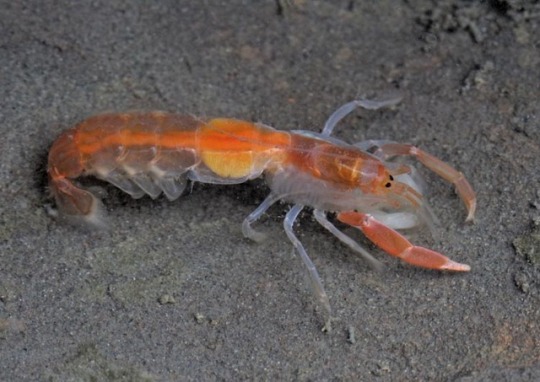#neotrypaea
Explore tagged Tumblr posts
Text





#ghost shrimp#neotrypaea#decapod crustacean.#marine life#catch and release#mission bay park#san diego
0 notes
Text
today's invertebrate...............neotrypaea gigas
it's the wood fairy!!! yippee!!!!! the wood fairy!!!!!!!! ask it for any kind of wood and you will find 10 luxurious planks of said wood near your house tomorrow!!!!
it only appears on the 9th of each month, so you better be quick!!
wood!!!!!! near your house!!!!!!! and for free too!!!!!! wood!!!!!!!!! wood!!!!!!!!!!! 🪵🪵🪵🪵🪵🪵🪵🪵🪵🪵🪵
..........jollyness rating: 65.3% wood perfect for glowing glorpsmas plant structure

photographed by Gregory C Jensen (crabsandshrimps), iNaturalist! link to original observation
11 notes
·
View notes
Text
These were a neat find at the beach. Kids dug down about and discovered these. Pacific Ghost shrimp.
#Wikipedia @Wikipedia
Neotrypaea californiensis (formerly Callianassa californiensis), the Bay ghost shrimp, is a species of ghost shrimp that lives on the Pacific coast of North America. It is a pale animal that grows to a length of 11.5 cm (4.5 in). One claw is bigger than the other, especially in males, and the enlarged claw is thought to have a function in mating.
#parksville #beach #ghostshrimp #pacificnorthwest #
0 notes
Photo


A bay ghost shrimp [Neotrypaea californiensis] photographed by Ron Wolf in California.
296 notes
·
View notes
Text

@peucetiaviridans I assume you're referring to Jacob Colvin on youtube/tiktok :)
In a vacuum, I'd be neutral-leaning-negative towards parasite removal. Parasites are important for population control, and are fascinating organisms in their own right. However, what Jacob is doing is quite a unique case. The shrimp species he traps are mud shrimps and ghost shrimps (Upogebia sp. and Neotrypaea sp.) and the parasite he removes is Griffen's isopod (Orthione griffenis).
The blue mud shrimp (Upogebia pugettensis) has had it really rough in the last few decades - after Griffen's isopod was accidentally introduced to the American West Coast in the late 1980s by cargo ships arriving from Asia, the blue mud shrimp has seen a steady decline.
The blue mud shrimp was once found in large populations all the way from Alaska and down to California. Nowadays they're extinct in the San Francisco Bay, almost extinct in California, and no known population is free from Griffen's isopod.
Manual removal is the only viable way to remove this isopod. Since both animals are crustaceans, any chemical solution would kill off the shrimp as well. And biological warfare is too risky to use. Capturing mud shrimps and removing parasites from them is beneficial on all accounts.
Please don't take this as an invitation to remove random parasites out in nature, though. The mud shrimp situation is one very very specific instance in which parasite removal is good. Under most other circumstances, parasite removal is not recommended.
I've run out of videos/photos to rate and queue - please tag me in anything you can find or DM it to me!
If you have any invertebrate questions, I'd also love to answer those! It doesn't have to be ethology/behavior related.
191 notes
·
View notes
Text


#ghost shrimp#neotrypaea californiensis#burrow#air holes#marine life#beach#tideline#light on water#bonita bay#mission bay park#san diego
3 notes
·
View notes
Text
@Wikipedia Neotrypaea californiensis
Neotrypaea californiensis (formerly Callianassa californiensis), the Bay ghost shrimp, is a species of ghost shrimp that lives on the Pacific coast of North America. It is a pale animal that grows to a length of 11.5 cm (4.5 in). One claw is bigger than the other, especially in males, and the enlarged claw is thought to have a function in mating.
#macrophotography #instagram #wikapedia #ghostshrimp #parksvillebc
Neotrypaea californiensis (formerly Callianassa californiensis), the Bay ghost shrimp, is a species of ghost shrimp that lives on the Pacific coast of North America. It is a pale animal which grows to a length of 11.5 cm (4.5 in). One claw is bigger than the other, especially in males, and the enlarged claw is thought to have a function in mating.
Caption above from @Wikipedia
0 notes